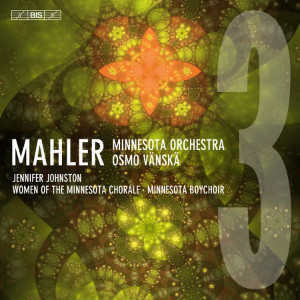
Gustav Mahler (1860-1911)
Symphony No 3 (1894-1896)
Jennifer Johnston (mezzo-soprano)
Women of the Minnesota Chorale, Minnesota Boychoir
Minnesota Orchestra/Osmo Vänskä
rec. live, 14-18 November 2022, Orchestra Hall, Minneapolis, USA
Reviewed as lossless 96 kHz/24-bit download
BIS BIS-2486 SACD [2 SACDs: 104]
As I listened to this recording, in stereo, I kept marvelling at the astounding combination of natural sound and hi-fi effect which the BIS engineers have achieved. An enormous dynamic range combines with an ability to allow every section of the orchestra to stand out and yet be naturally set in with the rest of the band. I have been engrossed in Mahler’s vision of nature in his ever-fresh third symphony.
Mahler annotated the original score with titles (he dropped them before publication). He described Part One as “Pan awakes” and “Summer marches in (Bacchic procession)”. Part Two had five titles: “What the flowers in the meadow tell me”, “What the animals in the forest tell me”, “What man tells me”, “What the angels tell me” and “What love tells me”.
The first movement, which makes up Part One (and SACD1), is an extraordinary mix of marches, threatening and less so, interspersed with contrasting episodes. I was pleased to read in the booklet that it is difficult to decide what constitutes a first or second subject – I long since gave up trying to make such a decision.
The very opening, an ominous tread, exploits the orchestra’s superb trombones, horns and trumpets. It is later interrupted by a thematic variant on woodwinds and violins that brings a little light into the proceedings. After a resplendent climax, the threatening march returns. The glorious closing pages permit the orchestra to thunder away at maximum power.
One notices that Osmo Vänskä likes to encourage the orchestra to play with extremes of dynamic. The recording engineers have catered for this with sound which effortlessly contrasts ppp with fff. The individual timbres of the instruments are brilliantly defined, be it contrabassoon or horn, and yet they are not spotlit. It is a remarkable achievement. I find the conductor’s vision of the movement very satisfying. It combines power with delicacy, with relaxation, delivered perhaps a little slower than usual.
On to the flowers of the second movement, which sway in a gentle breeze of a minuet and trio. It is a tuneful relaxation after what has gone before, charmingly played.
The third movement contains some of the most ravishing moments in all of Mahler’s music – the “posthorn serenade”. The orchestra have gone to the lengths of securing a true posthorn, photographed in the booklet. It is a gleaming Dotzauer Fürst Pless Rotor 18915 valved B flat posthorn. Beautiful though this performance is, I feel it just misses the last ounce of rapture that the London Symphony Orchestra led by Jascha Horenstein convey in their 1970 Unicorn Kanchana recording.
Jennifer Johnson is the outstanding mezzo-soprano in the fourth movement. The melody has a rocking feeling, created by alternating notes in the orchestra. It prefigures a similar device in the fifth movement, where the children’s chorus sings “Bimm-bamm” to imitate bells, supported by the women’s chorus and orchestra. Both choirs do very well.
The finale, some 24 minutes here, begins with a heart-easing melody – “What love tells me” – but love can bring ecstasy and despair in equal measure. Mahler makes sure that his music reflects that. Half way through, the music mounts to a tremendous climax which may represent ecstasy; then, the rapid decline into quiet, a rise again to a lesser climax and an immediate and even more intense one. All this reinforces the rather literal interpretation.
It is tempting to remember that in 1895-1896 Mahler had an intense, stormy affair with the beautiful young soprano Anna von Mildenburg. As far as I can see, however, this may not be a correct reading. There is a superscription on the draft score of the last movement that reads “Behold my wounds! Let that one soul be lost.” Mahler was in the slow process of converting to Catholicism in the years of the third symphony’s composition, and finally did so in February 1897. Perhaps the interpretation of the music should be one of love inspired by religion.
The music continues rising to further climaxes and then decrescendos, maybe representing calm after fury, and then to more immense kettledrum beats and brass chorales to the end.
Osmo Vänskä unerringly guides the orchestra through this maelstrom of emotions, and they respond magnificently. It seems that this recording was made the day after a live performance, so it is no surprise to me it comes across as a thoughtful performance. It is not what gets set down by a guest conductor who flies in, rehearses, performs and flies out. I have been extremely impressed, and I can confidently recommend it, especially if you want to hear a technically outstanding recording. The booklet is in English, German and French with translations of the sung texts.
Jim Westhead
Previous reviews: Ralph Moore (July 2024) ~ John Quinn (August 2024)
Buying this recording via a link below generates revenue for MWI, which helps the site remain free



















